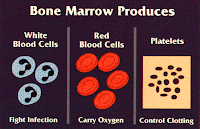Sunday, March 30, 2008
Fetal circulation/Cardiac Output
Cardiac output is the heart rate times the stroke volume. CO is the amount of blood (volume) pumped out by ventricles every 1 minute, which is about 5 to 6 liters. we have about 5 liters in our body so every minute our heart pumps all the blood in our bodies. Crazy!! The stroke volume is the blood being ejected from the ventricles.
Friday, March 21, 2008
The Heart


Saturday, March 15, 2008
Blood, Bone Marrow and Blood Types
In the picture below the blood cells look like cheerios....Dont they?
 I learned that blood is made up of Red Blood Cells - Erythrocytes, White Blood Cells - Leukocytes and Platelets - Thrombocytes. This was funny. The way to remember the 5 categories of white blood cells is this saying: never let monkeys eat banana's.
I learned that blood is made up of Red Blood Cells - Erythrocytes, White Blood Cells - Leukocytes and Platelets - Thrombocytes. This was funny. The way to remember the 5 categories of white blood cells is this saying: never let monkeys eat banana's.
N= Neurophils (70-80%) they are phagocytic cells which destroy foreign material and digest it
L= Lymphocytes (20-30%)
M= Monocytes (less than 10%) capable of many phagocytic events E= Eosinophil (3-8%) B= Basophil (less than 0.1%) releases Histamine, which is a blood vessel dilator

Bone marrow is found and is easily taken out of the flat bones in our body. The flat bones are the sternum, scapula's and the flat bone in the pelvis. The most common place for Red Bone marrow to be taken out is in the hips because there is less muscle and adipose tissue there.
BLOOD TYPES:
I just donated blood at the blood drive that was held here at EMCC. It was my very first time giving blood. I was not able to give too much because I started to think about it too much and was going to pass out. I can at least say that I did it and helped someone else. I do not know what type of blood that I have circulating in me. Which is should probably know. There are 4 types: A, B, AB and type Rh factor. It was interesting to see how it was possible to have a different blood type than a member of your family.
Sunday, March 9, 2008
Steriod Hormones
when we came back this week we talked about steriod hormones....
I really remember the estrogen hormone...cause well duh, I am a girl....lol
Estrogens diffuse easily across the cell membranes and when they are inside the cell body the interact with estrogen receptors.
Sex Hormones consist of androgens, estrogens & progestagens.
Corticosteriods consist of glucocorticiods and mineralcoritoids. Gluco controls metabolism & immune functions. Mineral controls blood volume.
Anabolic steriods increase bone and muscle synthesis.
steriod hormones are basically transported in the blood.
I will add more later....


